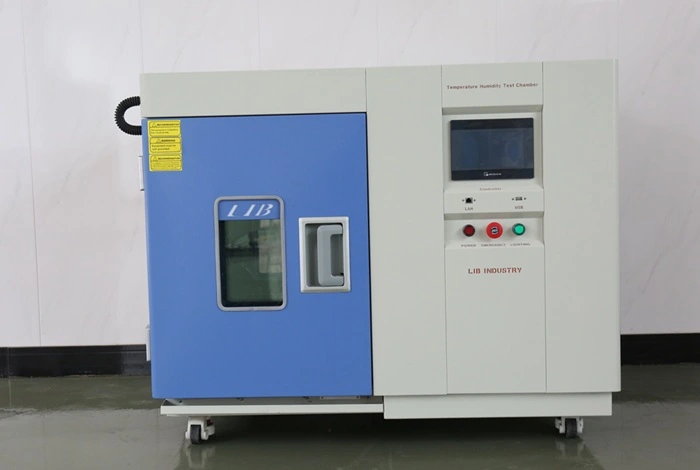Key Design Features of High-Precision Temperature Calibration Chambers
Key Design Features of High-Precision Temperature Calibration Chambers
High-precision temperature calibration chambers represent sophisticated engineering solutions that combine advanced thermal control, robust construction, and intelligent monitoring systems. These specialized environments achieve temperature stability within ±0.5°C fluctuation, utilizing PID-controlled refrigeration systems, multi-layered insulation, and precision platinum resistance sensors. Modern chambers integrate programmable controllers with Ethernet connectivity, enabling remote monitoring and automated calibration protocols. From aerospace component testing to pharmaceutical validation, these chambers deliver the accuracy and repeatability essential for maintaining measurement traceability across industries requiring exacting thermal specifications.

Temperature Control System Architecture and PID Algorithms
Dual-Stage Refrigeration Configuration
Advanced temperature calibration chambers employ mechanical compression refrigeration systems featuring French TECUMSEH compressors paired with environmentally responsible refrigerants. The dual-stage architecture enables chambers to achieve temperature ranges spanning from -70℃ to +150℃, accommodating diverse calibration requirements. This configuration maintains consistent cooling rates of approximately 3℃ per minute while balancing energy consumption against performance demands.
Proportional-Integral-Derivative Control Logic
The heart of thermal precision lies within PID algorithms that continuously adjust heating and cooling outputs based on real-time sensor feedback. These mathematical controllers analyze temperature deviations, calculate correction rates, and implement proportional responses that prevent oscillation around setpoints. The integration minimizes overshoot during thermal transitions, ensuring calibration accuracy remains uncompromised throughout extended testing protocols.
Nichrome Heating Element Integration
Nichrome heaters provide responsive thermal input with heating rates reaching 1℃ per minute. The resistance-based elements distribute heat uniformly across chamber volumes, working in concert with refrigeration systems to achieve rapid equilibrium. Strategic placement within air circulation pathways maximizes thermal transfer efficiency while maintaining component longevity under repeated cycling conditions.
Thermal Component | Specification | Performance Impact |
Compressor Type | TECUMSEH (French) | -70℃ minimum achievable |
Cooling Rate | 3℃/min | Rapid stabilization |
Heating Rate | 1℃/min | Controlled warm-up cycles |
Heat Load Capacity | 1000W | Accommodates test specimens |
Insulation Materials and Thermal Shielding Technology
Polyurethane Foam Core Structure
Multi-density polyurethane foam creates the primary thermal barrier, minimizing heat exchange between chamber interiors and ambient environments. The cellular structure traps air pockets that dramatically reduce thermal conductivity, enabling temperature calibration chambers to maintain extreme temperatures with manageable energy input. Foam thickness varies across chamber models, correlating directly with achievable temperature ranges and stability specifications.
Insulation Cotton Supplementary Layers
Beyond polyurethane foundations, specialized insulation cotton provides secondary thermal protection in critical zones. This fibrous material absorbs residual heat transfer, particularly around access points and structural joints where thermal bridging risks emerge. The combination creates redundant protection that ensures temperature deviation remains within ±2.0℃ across entire chamber volumes.
Double-Layer Window Sealing Systems
Observation windows incorporate double-layer thermostability silicone rubber seals that maintain visual access without compromising thermal integrity. The silicone composition withstands extreme temperature cycling while maintaining elastic properties that ensure airtight closure. Interior lighting systems integrate without creating thermal weak points, enabling specimen monitoring throughout calibration procedures.
Chamber Construction and Air Circulation Design
Stainless Steel Interior Configuration
SUS304 stainless steel interiors provide corrosion-resistant surfaces that withstand condensation, thermal stress, and chemical exposure from test specimens. The non-reactive material prevents contamination while facilitating cleaning protocols between calibration runs. Welded construction eliminates crevices that could trap moisture or compromise thermal uniformity across working volumes ranging from 100L to 1000L.
Centrifugal Wind Fan Circulation
Strategic air circulation patterns utilize centrifugal wind fans to eliminate thermal stratification within chambers. The forced convection continuously moves conditioned air across specimens, ensuring uniform temperature exposure regardless of shelf position. Adjustable-height shelving with perforated surfaces promotes airflow penetration, enabling simultaneous calibration of multiple sensors with consistent thermal exposure.
Protective Exterior Coating Systems
Steel plate exteriors receive specialized protective coatings that resist environmental corrosion while providing structural rigidity. The multi-layer finish withstands industrial environments where temperature calibration chambers operate continuously, protecting internal insulation and control systems from humidity and chemical exposure. Powder-coat applications ensure long-term aesthetic quality alongside functional durability.
Construction Element | Material | Purpose |
Interior Walls | SUS304 Stainless | Corrosion resistance |
Insulation | Polyurethane foam | Thermal barrier |
Exterior Shell | Coated steel plate | Structural integrity |
Shelving | Perforated steel | Air circulation |
Sensor Ports, Calibration Wells, and Access Interfaces
PT-100 Class A Platinum Resistance Sensors
Temperature measurement relies on PT-100 Class A platinum resistance thermometers that detect thermal changes at 0.001-degree resolution. The platinum elements exhibit predictable resistance variations across wide temperature ranges, providing reference accuracy essential for calibration traceability. Sensor positioning throughout chamber volumes enables multi-point verification of thermal uniformity during validation protocols.
Standard Cable Port Configuration
Each chamber includes standard cable ports with Φ50mm diameter openings equipped with sealing plugs. These passages accommodate thermocouple wires, power supplies, and data cables for specimens under test without compromising chamber integrity. The grommet design maintains thermal sealing while enabling external connections critical for device-under-test operation during calibration procedures.
Adjustable Shelf Access Systems
Interior configurations feature removable shelving systems with height-adjustable mounting positions. This flexibility accommodates specimens of varying dimensions while maintaining optimal air circulation patterns. The shelf design supports heat load distributions up to 1000W, enabling calibration of active devices that generate thermal output during operation.
Data Logging, Connectivity, and Software Integration
Programmable LCD Touchscreen Controllers
Modern temperature calibration chambers incorporate color LCD touchscreen interfaces that simplify programming complex thermal profiles. The intuitive controls enable operators to define multi-segment temperature ramps, hold periods, and cycling patterns without specialized training. Real-time graphical displays present chamber status, providing immediate feedback on thermal performance and deviation alerts.
Ethernet Network Integration
Built-in Ethernet connectivity transforms chambers into networked assets within laboratory management systems. The PC Link capability enables remote monitoring, automated data extraction, and integration with calibration management software. Network access supports compliance documentation requirements, automatically generating timestamped temperature records for regulatory submissions.
Automated Profile Execution
Programmable controllers execute stored thermal profiles with precise timing and temperature control. The automation eliminates manual intervention during extended calibration sequences, reducing operator errors while ensuring repeatability across multiple calibration events. Profile libraries accommodate industry-standard calibration protocols, accelerating validation procedures.
Connectivity Feature | Capability | Benefit |
Touchscreen Interface | Profile programming | Simplified operation |
Ethernet Access | Remote monitoring | Real-time oversight |
Data Logging | Automated records | Compliance documentation |
PC Link | Software integration | System connectivity |
Safety Mechanisms and Energy Efficiency Considerations
Multi-Layer Protection Systems
Comprehensive safety architecture includes over-temperature protection that halts heating operations when thermal limits exceed programmed thresholds. Over-current protection safeguards electrical components from power surges, while refrigerant high-pressure protection prevents compressor damage. Earth leakage protection ensures operator safety, particularly critical when chambers operate with lithium-ion battery specimens that present unique hazards.
Thermal Management Optimization
Energy efficiency emerges from intelligent thermal management that minimizes heating and cooling conflicts. The control systems coordinate compressor operation with heater activation, avoiding simultaneous opposing actions that waste energy. Insulation quality directly impacts operational costs, with superior thermal barriers reducing the work required to maintain extreme temperatures.
Lithium-Ion Battery Testing Safeguards
Specialized safety options address risks associated with lithium-ion battery calibration and testing. These provisions include pressure relief mechanisms, flame-resistant interior materials, and enhanced ventilation systems that manage thermal runaway scenarios. The safety enhancements enable battery manufacturers to conduct essential validation procedures with reduced facility risks.
LIB Industry Temperature Calibration Chamber: Precision Engineered Design
Comprehensive Model Range
LIB Industry offers temperature calibration chambers spanning from compact 100L models (T-100) to expansive 1000L configurations (T-1000). The range addresses diverse laboratory footprints while maintaining consistent performance specifications across the product line. Overall dimensions scale proportionally, with the largest model measuring 1500mm × 1540mm × 2140mm, accommodating substantial specimen volumes.
Temperature Range Versatility
Three distinct temperature range options serve varying calibration requirements. Range A (-20℃ to +150℃) addresses standard industrial applications, while Range B (-40℃ to +150℃) extends capability for cold-climate component validation. Range C (-70℃ to +150℃) provides extreme low-temperature capability essential for aerospace and specialty applications requiring cryogenic calibration points.
Turn-Key Solution Integration
Beyond equipment supply, LIB Industry provides comprehensive support encompassing research, design, production, commissioning, delivery, installation, and operator training. This turn-key approach ensures chambers integrate seamlessly into existing calibration workflows, minimizing implementation timelines. Technical support extends throughout equipment lifecycles, maintaining calibration accuracy through preventive maintenance and periodic revalidation services.
Application Across Industries
Temperature calibration chambers serve critical roles in electronics manufacturing, pharmaceutical validation, aerospace component qualification, and research laboratories. Electronics manufacturers verify sensor accuracy for consumer devices, while pharmaceutical companies validate environmental monitoring systems ensuring product integrity. Aerospace applications demand extreme temperature performance for component qualification under operational conditions, making high-precision chambers indispensable tools.
LIB Chamber Model | Internal Volume | Overall Dimensions | Ideal Applications |
T-100 | 100L | 900×1050×1620mm | Small component testing |
T-225 | 225L | 1000×1140×1870mm | Sensor calibration |
T-500 | 500L | 1200×1340×2020mm | Multi-device validation |
T-800 | 800L | 1300×1540×2120mm | Battery testing |
T-1000 | 1000L | 1500×1540×2140mm | Large specimen qualification |
Conclusion
High-precision temperature calibration chambers embody sophisticated engineering that merges thermal control systems, robust construction, and intelligent monitoring capabilities. The integration of PID algorithms, platinum resistance sensors, and mechanical refrigeration creates environments achieving ±0.5℃ stability across extreme temperature ranges. Strategic insulation, forced air circulation, and stainless steel construction ensure long-term reliability while programmable controllers with network connectivity streamline calibration workflows. These design features collectively enable measurement traceability essential for quality assurance across electronics, pharmaceutical, aerospace, and research applications.
FAQs
What temperature uniformity can high-precision calibration chambers achieve?
Modern temperature calibration chambers maintain temperature deviation within ±2.0℃ across the working volume with fluctuation controlled to ±0.5℃ at setpoint. This uniformity results from forced air circulation, strategic insulation placement, and PID-controlled heating and cooling systems that continuously balance thermal inputs throughout the chamber interior.
How do PT-100 sensors contribute to calibration accuracy?
PT-100 Class A platinum resistance sensors provide reference-grade temperature measurement with 0.001-degree resolution. The platinum element's predictable resistance change with temperature enables traceable calibration across wide ranges. Multiple sensor placement throughout chambers verifies thermal uniformity, ensuring specimens receive consistent exposure regardless of position during calibration procedures.
What safety features protect lithium-ion battery testing?
Specialized chambers for lithium-ion battery calibration incorporate enhanced safety mechanisms including over-temperature protection, pressure relief systems, flame-resistant interior materials, and advanced ventilation. These provisions manage thermal runaway risks while enabling essential battery validation procedures, protecting both equipment and facility from potential hazards associated with energetic cell testing.
As a leading temperature calibration chamber manufacturer and supplier, LIB Industry delivers precision-engineered environmental testing equipment with comprehensive turn-key support. Contact our technical team at ellen@lib-industry.com to discuss your specific calibration requirements and explore customized chamber configurations for your facility.



